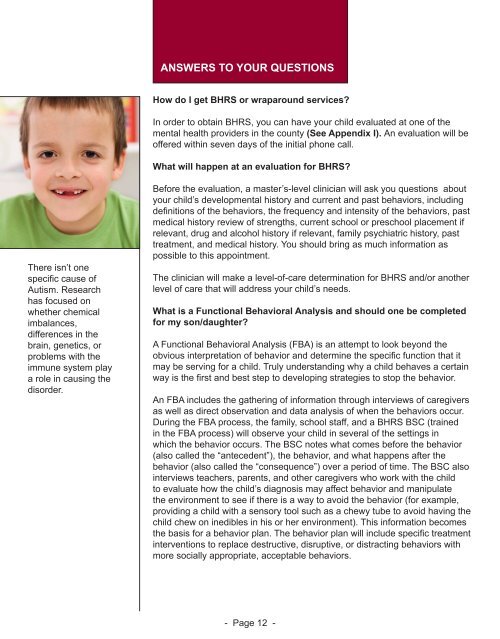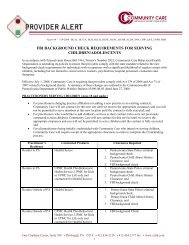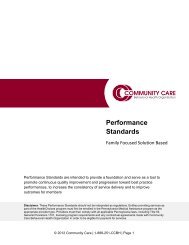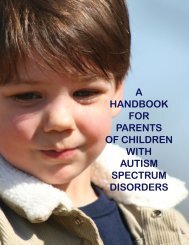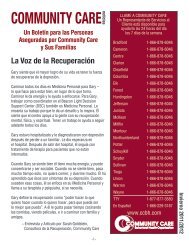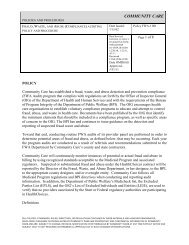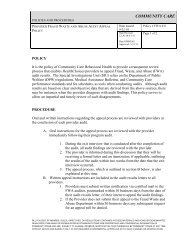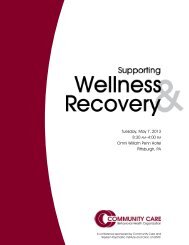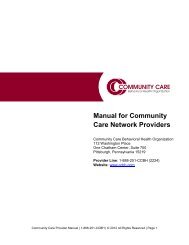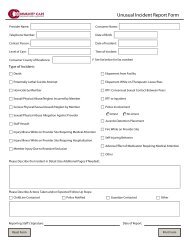a handbook for parents of children with autism spectrum disorders
a handbook for parents of children with autism spectrum disorders
a handbook for parents of children with autism spectrum disorders
- No tags were found...
Create successful ePaper yourself
Turn your PDF publications into a flip-book with our unique Google optimized e-Paper software.
ANSWERS TO YOUR QUESTIONSHow do I get BHRS or wraparound services?In order to obtain BHRS, you can have your child evaluated at one <strong>of</strong> themental health providers in the county (See Appendix I). An evaluation will be<strong>of</strong>fered <strong>with</strong>in seven days <strong>of</strong> the initial phone call.What will happen at an evaluation <strong>for</strong> BHRS?There isn’t onespecific cause <strong>of</strong>Autism. Researchhas focused onwhether chemicalimbalances,differences in thebrain, genetics, orproblems <strong>with</strong> theimmune system playa role in causing thedisorder.Be<strong>for</strong>e the evaluation, a master’s-level clinician will ask you questions aboutyour child’s developmental history and current and past behaviors, includingdefinitions <strong>of</strong> the behaviors, the frequency and intensity <strong>of</strong> the behaviors, pastmedical history review <strong>of</strong> strengths, current school or preschool placement ifrelevant, drug and alcohol history if relevant, family psychiatric history, pasttreatment, and medical history. You should bring as much in<strong>for</strong>mation aspossible to this appointment.The clinician will make a level-<strong>of</strong>-care determination <strong>for</strong> BHRS and/or anotherlevel <strong>of</strong> care that will address your child’s needs.What is a Functional Behavioral Analysis and should one be completed<strong>for</strong> my son/daughter?A Functional Behavioral Analysis (FBA) is an attempt to look beyond theobvious interpretation <strong>of</strong> behavior and determine the specific function that itmay be serving <strong>for</strong> a child. Truly understanding why a child behaves a certainway is the first and best step to developing strategies to stop the behavior.An FBA includes the gathering <strong>of</strong> in<strong>for</strong>mation through interviews <strong>of</strong> caregiversas well as direct observation and data analysis <strong>of</strong> when the behaviors occur.During the FBA process, the family, school staff, and a BHRS BSC (trainedin the FBA process) will observe your child in several <strong>of</strong> the settings inwhich the behavior occurs. The BSC notes what comes be<strong>for</strong>e the behavior(also called the “antecedent”), the behavior, and what happens after thebehavior (also called the “consequence”) over a period <strong>of</strong> time. The BSC alsointerviews teachers, <strong>parents</strong>, and other caregivers who work <strong>with</strong> the childto evaluate how the child’s diagnosis may affect behavior and manipulatethe environment to see if there is a way to avoid the behavior (<strong>for</strong> example,providing a child <strong>with</strong> a sensory tool such as a chewy tube to avoid having thechild chew on inedibles in his or her environment). This in<strong>for</strong>mation becomesthe basis <strong>for</strong> a behavior plan. The behavior plan will include specific treatmentinterventions to replace destructive, disruptive, or distracting behaviors <strong>with</strong>more socially appropriate, acceptable behaviors.- Page 12 -


